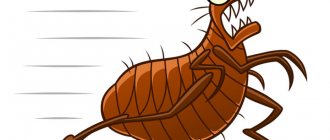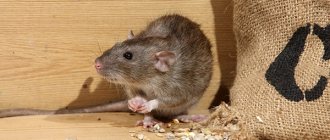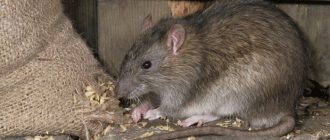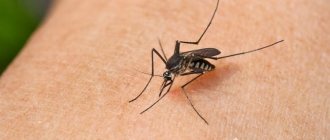Rats often choose country houses, food warehouses and other premises with food sources and unfavorable sanitary conditions as their habitat. The appearance of rodents near a person threatens not only spoiled things and food. If at least one individual is found in the house, the control process should immediately begin. Animals are distinguished by good survival and adaptability, high productivity, which allows them to quickly increase their population size.
Rats are carriers of pathogens of many dangerous diseases and infections. The fight against rodents begins with studying information about the characteristics of their life, reproduction, and physiology. The result of extermination measures will largely depend on knowledge of what rats are afraid of. In the fight against rodents, it is important to deprive animals of comfortable living conditions, cut off the path to a food source, and use preventive measures to prevent the reappearance of unwanted individuals. To do this, you should keep the room clean, avoid the accumulation of garbage and unwashed dishes, and do not leave food in the public domain.
The arsenal of modern means aimed at getting rid of rats is presented in a wide variety - these are folk remedies, repellent smells and sounds, various traps with glue and poisonous baits, chemicals, ultrasonic equipment. They differ in their effectiveness. The choice of a specific method should include an analysis of the situation and a preliminary assessment of the population size. The process of fighting rats is complicated by the rapid adaptation of rodents to new conditions and unfavorable factors.
What rats are really afraid of and don't like
Perhaps the main problem of repelling rats is that, with rare exceptions, these animals are afraid of the same smells and sounds that are unpleasant to humans.
To get rid of rodents without disturbing your comfortable living indoors, you should use means that are familiar to humans or completely invisible, but which rats cannot tolerate. Among them:
- Ultrasonic rodent repellers (high-quality, not Chinese tweeters) - people do not hear ultrasound, but rats perceive it and at a certain frequency and intensity - they are afraid (more precisely, they experience discomfort);
- Cats (and to a lesser extent, their smell);
- Bright light (provided that the animals are not used to it);
- Loud sounds;
- Sounds with which rats themselves transmit danger signals to each other.
A common disadvantage of such influences is that rats can get used to them, and the longer a particular sound or smell affects rats, the less they can be afraid of it. This means that when using one or another option, you should always take into account the likelihood of rodents developing individual immunity to deterrents.
Fortunately, addiction in animals does not develop very quickly, and it is often possible to drive them away long before they become immune to one or another influence.
On a note
To effectively fight rodents in a private home, it is also useful to know which insulation is not chewed by rats and mice, since the wrong choice of insulation can create ideal conditions for rodents to live in the walls of the house and in the attic. We’ll talk about this in more detail below, but for now we’ll just note that, contrary to popular belief, glass wool in most cases is not able to scare away rats - rodents can easily make their moves in it.
The effectiveness of the repellent method
It’s worth saying right away that opinions differ regarding the effectiveness of the scaring method. There are those who support this method and talk about good results, but there are also those who say that it is completely ineffective.
But despite the controversial issues, for a long time people have been using a variety of aromatic herbs and remedies that can drive rats away from the territory.
In many ways, the effectiveness depends on the correct use of a particular product. You need to understand how the substance can affect the rodent and what results to expect.
Repellent substances are not capable of destroying pests; they are intended to make the animal feel uncomfortable and create the most unfavorable living conditions so that they want to leave the house.
How to drive rats out of non-residential premises
If it is necessary to expel rats from a non-residential premises, for example, a bathhouse or a barn, then you can use products that emit a strong odor. And here we are not talking about special chemicals. But what smell are rats afraid of? Let's look at this issue in detail.
Vishnevsky ointment
It must be diluted with water to obtain a thick consistency. The resulting mixture should be spread on the floor in a non-residential area and closed for several days. It is important to note that Vishnevsky’s ointment is not suitable for external treatment.
Singed wool
It is necessary to burn natural fur over a fire and bring it indoors. Also suitable for this method are fluff or burnt rubber. It is installed next to the minks.
Various substances
These include:
- kerosene;
- tobacco;
- vinegar;
- bleach;
- hot peppers.
Do not forget that during the treatment all animals and birds should not be allowed into the room, and after the treatment the building must be ventilated.
Herbal essential oils
In pharmacies you can buy essential oils that are prepared from herbs. The aroma from the essential oil will be stronger and richer than from fresh or dried herbs. It will be felt longer.
It is known that rats are afraid of the smell of peppermint essential oil. The same goes for mice. The oil is dripped onto cotton pads or napkins and placed in the corners of the rooms.
You can drop a few drops into the water before washing the floors. The smell will be felt throughout the house, so you shouldn’t overdo it. The pungent aroma causes headaches and dizziness.
In addition to mopping the floors, you can diffuse essential oil from a spray bottle. To do this, drop from 1 to 15 drops of oil into 300 ml of water and add 10 ml of alcohol. The mixture is applied wherever animals may be.
Special aroma lamps are sold in stores. The essential oil evaporates along with the smoke, and the smell penetrates into all the cracks.
Direct contact of the animal with the oil must be avoided. If it gets on the fur of a rodent, it will lead to death. For lovers of humane methods of elimination, murder is definitely not suitable.
Plant control
Representatives of previous generations knew what grass mice and rats are afraid of. The repellent smell forces them to leave human possessions. The presence of the potion protects against re-infection
Expulsion from non-residential premises
Several plants have been used since ancient times, which have repeatedly proven their effectiveness. Application does not require special skills, but caution is required:
- Elder. They lay them out along the walls, in the corners, and stuff them into holes. Protection is updated after a week. At the dacha, in the garden, an elderberry bush is planted. You don't have to invent anything with smells. In an apartment or residential building, elderberry is used with caution, since the plant contains toxic hydrocyanic substances. It is forbidden to use this herb against mice if there are animals or small children in the house.
- Ledum. The poisonous properties of wild rosemary have been known for a long time. The plant not only repels mice and rats with its smell, but can also kill. Ledum essential oils are hazardous to human health and are recommended for use in non-residential premises, warehouses, barns, and garages. The repellent smell lasts about 10 days.
- Blackroot officinalis. No plant can compare with this potion in terms of effectiveness. The potion is popularly called a rat killer. The plant has a sharp, repellent odor, as well as many spines that contain poison. Upon contact with blackroot, the spines cling to the fur of rodents, dig into the skin, and release toxic substances. Rodents are most afraid of contact with this plant. To poison pests, the seed is mixed with flour and sugar.
Plants against rodents
Important!
When working with a dangerous potion, you must protect your hands with rubber gloves and wear a gauze bandage. The black root is dipped in boiling water for a few minutes and placed in the right places.
The repellent effect of the plants lasts as long as the aroma lasts. With its disappearance, performance decreases. Bundles of potion should be renewed periodically to maintain the smell. It is also necessary to alternate scents, since with prolonged use, pests become addicted.
Expulsion of rodents from residential premises
Plants against rats and mice are used in apartments and houses. But they use a potion that is safe for human life and health:
- sagebrush;
- pharmaceutical camomile;
- tansy;
- peppermint;
- pyrethrum.
The smell of chamomile, mint, and pyrethrum has a beneficial effect on a person’s well-being - it calms the nervous system, normalizes sleep, and improves breathing. For rats and mice, the smell is one of the most annoying and unpleasant.
Anti-rat grass in the house The plant is placed around the perimeter of the rooms, in the corners. You can use dry potion, fresh. But it should be updated as the smell disappears. For greater efficiency, create a bouquet of several components.
You need to be careful with tansy and wormwood. The rich smell of these plants drives rats and mice out of the room in a matter of days, but can harm humans. Headache, nausea, weakness, and sleep disturbance appear. To avoid this, you need to distribute the potion in small quantities. Rodents' sense of smell is much sharper than that of humans; they detect even the faintest odors.
On a note!
Instead of plants, you can use essential oils to repel rats and mice. Drop onto a napkin, add to water for washing floors, apply to a light bulb, saturate a candle or wood. Carrying out the daily procedure in the evening makes life unbearable for pests, but for humans it will smell pleasant. After a few days the animals will leave the premises.
You can create living protection around the house - plant mint bushes around the perimeter, spread chamomile, tansy, or other fragrant herbs. Plants prevent rats and mice from leading a full life; you can get rid of them without using dangerous poison.
Additional methods
You can scare away rats with harsher substances. Among the folk remedies you can find turpentine, kerosene, cologne, ashes from the skins of killed rats, etc. All substances are toxic and have a pungent odor. Therefore, the use of most products in an apartment or residential building is impossible.
Kerosene
It is recommended to spray the habitats of parasites with kerosene. In basements and attics it makes sense to install a container with liquid. The smell of fuel will emanate constantly. Therefore, rodents will try not to return to their habitual place. If the animal gets into the liquid, it will die.
Naphthalene
Naphthalene has a sharp, specific odor. The solid substance not only repels rodents, but is also toxic to them. It is recommended to mix naphthalene with sawdust and scatter the mixture in mouse habitats. Such flooring will cause animals to panic and try to leave the room. It is recommended to use mothballs to remove rodents from non-residential premises.
Turpentine
Turpentine has a similar effect to kerosene. The liquid has a pungent odor that causes discomfort to living beings. It is recommended to coat the corners of the room with turpentine, or place a container with it next to mouse holes. The aroma of fuel persists for a long time and does not dissipate well, so rodents do not appear for a long time.
Burnt fluff
Burnt feathers are another effective method of repelling parasites. Pests cannot tolerate the smell of burnt fluff and avoid its locations. You can burn any feathers. Duck down has the most unpleasant aroma. Ashes must be mixed with starch and scattered in places where rodents have been seen.
Burnt rat fur
It is believed that rats are acutely aware of danger. Therefore, people have been using the method of repelling rodents for many years, which involves the use of the corpses of their relatives. Killed rodents must be skinned and burned. After this, the singed wool becomes the most terrible rat repeller.
Cologne
Cheap cologne, which you can buy at a department store, is an effective mouse repellent. The perfume has a sharp and persistent odor. Sensing the aroma, rodents try to retreat. It is recommended to use cologne not only in outbuildings, but also in apartments.
Chlorine solution
Bleach and chlorine-containing substances not only repel rats, but also kill them. Experienced housewives place jars of whiteness around the house. They prevent rats from leaving their holes. If the liquid enters the body, the animal dies.
Jars with chlorine solution must be covered with a plastic or metal lid, after making several holes in it.
Glass wool
Glass wool does not emit an odor, so it is used in residential areas. Insulation is added to food baits, which must be placed near mouse holes. Once in the body, glass wool injures the rodent's stomach. This causes instant death of the animal from internal bleeding.
Glass wool can be added to the soil mixture and sprinkled over the paths along which mice move.
The smell of rats in vegetable gardens and garden plots
On land, rats can cause much more damage than indoors. Destroyed crops, dried flowers, dead garden trees - all this is the work of rodents. You can protect your territory with plants that have a strong aroma. Daffodils planted in a flower bed with other flowers are considered reliable protection against rats.
Currently reading: Exterminating mice and rats - the most reliable methods of control
However, they bloom in early spring, and an invasion of rats is observed closer to autumn. In flower beds and beds you can plant chamomile, calendula, wormwood, and coriander. Rodents generally stay away from the smell of the latter. You can use peppermint living protection around your home. By the way, this plant will protect the room not only from rodents, but also from insects. For example, ants.
Around the cellar, near the trees, you can lay out plucked but fresh tansy, wormwood, and chamomile herbs. In this simple way you can protect your property and crops from numerous damages and losses. Smell is the basis for rats. Thanks to the aroma, they find food and their relatives. The presence of an unpleasant aroma of odorous grass confuses rodents. A rat cannot stay in such conditions for long. Forced to leave the premises. Fragrant grass around the house can block the path of rodents even before they enter human housing. Thus, it is always necessary to remember about preventive measures. The fragrant herb is most suitable for these purposes. It is better to get rid of rats before they appear.
Using the scents of natural enemies
It's no secret that rodents are afraid of cats, which are considered their main “thunderstorm.” However, this trend is more true for village cats than for pets living in comfortable apartments.
But should you be upset if your purr runs away in fear from one type of mouse, and you can’t rely on his hunting instincts? No, because you can drive out uninvited gray guests using the smell of a cat, or rather its urine. To do this, you can place used cat litter near the holes or soak rags with urine. Inhalation of ammonia vapor leads to a sharp decrease in the number of mouse offspring, causing the population to die out faster.
However, even more than cats, small rodents are afraid of snakes and rats. For the former, they act as natural food, while the latter fight with them for the same food sources and destroy their burrows. Therefore, mice can smell the excrement of their enemies a mile away and avoid them. You can easily become the owner of this “wealth” in any pet store.
Using these methods in an apartment is not very pleasant, but they are quite suitable for dachas, vegetable gardens and non-residential premises.
Where to file a complaint about rats
Independent attempts to get rid of pests may not bring results if comprehensive measures are not taken. To organize pest control throughout the entire entrance or in the private sector, you need to contact the management company, Rospotrebnadzor or higher authorities.
In the private sector
The answer to the question of where to file a pest complaint depends on the cause of the problem. The property owner is obliged to maintain favorable sanitary and epidemiological conditions. If rats have appeared in the house due to neglect of prevention rules, you will have to deal with the problem yourself.
If there are unfavorable third-party factors, you can file a complaint with Rospotrebnadzor. The reason could be, for example, non-compliance with sanitary standards by neighbors or the construction of an illegal dump next to the house. If this does not help, you can file a claim “To eliminate obstacles to the use of residential premises” in court.
In apartments
The manager is obliged to maintain a favorable sanitary and epidemiological situation at home and ensure safe living conditions, therefore, if rodents are found in the entrance, you must submit a statement to the Criminal Code. The complaint is written in any order, but you must indicate your personal data, fill out the header of the document (Article 7.22 of the Administrative Code), describe the problem and ask for an inspection. Leave a signature and date at the bottom.
Officially, the processing time for an application is 1 month, so residents often have to deal with the problem on their own, since during this time animals can breed and cause damage to property.
Discussion is closed.
Using the contents of the kitchen cabinet
If you don’t have a cat and don’t want to spend money on purchasing plant extracts, ordinary spices available in the arsenal of any housewife will help. The smell will help save supplies from the invasion of gray guests:
- carnations;
- coriander or cilantro;
- red pepper;
- sage;
It is allowed to use powder or seeds of these seasonings. Dry sage leaves, which are best burned, are also suitable. The strong aroma of coffee will also help repel rodents; freshly roasted beans work best.
Also, pests do not like the scent of vinegar, which can be poured into small containers and placed around the room. Although this option is more suitable for protecting cottages from rodents in the winter, since constantly inhaling a pungent odor is not only unpleasant, but also unsafe. The aroma of bleach scattered in the corners is also suitable for the same purpose.
How to use scents correctly
The result of the fight largely depends on correct application. Therefore, when using aromatic products you need to adhere to some rules:
- Substances must be placed in close proximity to the burrows. They are installed in small containers or applied to fabrics and cotton pads. Essential oils can be added to water and rinsed the floors, and corners can also be treated.
- To make dry plants and herbs smell longer, they need to be placed in small rag bags.
- Be sure to change fresh plants, since the aromas disappear very quickly, which means their effectiveness is lost.
- It is recommended to change aromatic substances from time to time, since rats have the ability to get used to them.
- In order for the result to be as positive as possible, you can use several products at the same time.
- You cannot use toxic products or those that can cause an allergic reaction in humans in residential areas.
- Use products with caution when there are pets in the house.
Ultrasound and methods of its application
Rats and mice hear sound with a frequency of up to 80-100 kHz, while humans are no longer practically unable to perceive vibrations with a frequency above 20 kHz. Sound with a frequency above 20 kHz is called ultrasound, and it meets one of the requirements for rodent repellents - to affect rats and mice without affecting humans.
It has been verified that devices that emit sound waves with frequencies from 20 kHz to 70 kHz can indeed repel rats quite effectively. In this case, an effective repeller must not only generate ultrasound, but also have a number of other important characteristics.
Here are the most significant of them:
- High sound pressure (a parameter similar to volume, but in the ultrasonic range). The higher the sound pressure, the higher the likelihood that rats will not tolerate the sounds produced by the device and will leave the area;
- The wide directional pattern of emitted ultrasound determines in which direction and how widely the sound travels. Ideally, it should approach 360°, that is, in fact, ultrasound in this case will spread evenly around the entire repeller. Most devices claim this angle, but in fact their ultrasonic radiation pattern barely reaches 50°;
- Automatically changing ultrasonic frequency. It is important to understand that not all ultrasound scares rats. Just as not every sound causes discomfort in humans, not every ultrasound repels rodents. But if the device constantly changes the frequency of the emitted ultrasound, then periodic discomfort will not be avoided for rodents.
The most effective ultrasonic repellers against rats today include Biostrazh, Chiston 2, Chiston 2 PRO, Tornado 800, TM-315 and some others. They are also one of the most expensive. More affordable devices are not as powerful, and some of the cheapest ones are outright junk, useless and not at all capable of scaring rats.
In addition, rats can get used to ultrasound, just like any other sounds. This, although rare, does happen. In this situation, pests may leave the room at first when the device is turned on, but then they will return again.
Ultrasonic repellers, when used correctly, do not have a negative effect on people, but may cause headaches for some. It should also be taken into account that cats and dogs hear ultrasound well, especially domestic mice, rats and hamsters, and therefore if there are pets in the house, such a device may not be able to be used.
Do ultrasonic repellers help?
Do ultrasonic repellers help? Numerous publications by experienced experts often write the following: “Recently, the ultrasonic method has been successfully used.
Its work is based on the use of sound waves of a certain frequency, which causes the animals a feeling of anxiety and discomfort, and they leave the habitat that is inconvenient for them.”
We turned to this method, hoping for it as a panacea. O great power of advertising persuasion!
An ultrasonic device for repelling rats and mice from a brand renowned in numerous media outlets was perceived by us as something modern and effective and impeccable.
Many thanks to our neighbor Nadezhda, who convinced us not to run for a super-remedy, but to take their repeller for a couple of days.
Let's try out the device. We plug it in and wait for hordes of rodents to rush out of our house under the influence of miracle sounds. The device crackles comfortably. And nothing happens. As it turned out, rodents wanted to sneeze on the miracle device.
Maybe this particular device is defective? Friend Natalya from the house opposite throws up her hands:
By the way, Natalya’s device turned out to have a different name than the one we tested. But, alas, it didn’t help. A resourceful seller of ultrasonic products, who was finally found, is convinced:
You can't deny the seller of miracle devices some entrepreneurial spirit.
Flour with a dangerous secret
As you know, rodents are always eager to eat flour. This is the basis of another so-called proven method of combating them using a gypsum-flour mixture.
A dry mixture is prepared from wheat flour and building plaster in a 1:1 ratio. The bait is poured, for example, into a plate in the amount of 1/2 cup per individual (for a rat). Water for drinking is placed nearby.
When the rodent has eaten and drunk, the mixture solidifies in its stomach within five minutes, and the animal dies. The bait has a familiar smell and does not arouse suspicion. Tests on the ground have proven that we transferred the products completely in vain. In our case, flour with gypsum turned out to be completely ineffective.
A product with a marine name
In desperation, we took the most severe measures - chemical ones. They were a little afraid to use poisons because they had a small kitten growing up at home. Pet products seller Tatyana said:
Another trick I learned: it’s easier to fight mice using poisoned grain bait, while rats prefer food in briquettes. We purchased a poison with a marine name: the package contained 8 briquettes in small bags. We laid out the poison in the cellar. The next day everything was eaten.
Attention! Baits with a slow-acting drug that accumulates in the body must be placed 3-4 days in a row or 2-3 times every other day. The next day and the day after - the situation repeated itself
We placed baits, and the rats ate them intensively.
We saw the first result on the fifth day: the night noises stopped all at once. The potatoes in the cellar no longer disappeared. The drug caused blood clotting disorders and suffocation in rats, which is why they intuitively began to look for a way out and went out of the house into the street, where they could easily be collected and destroyed.
Calico cat - double strike
Cat against rats People say that the most courageous and implacable fighter against rats is a tricolor cat.
Intuitively, we got just such a cat.
Three months after completely defeating the rat family, we suddenly discovered our seven-month-old Muska playing with the defeated rat.
From this we concluded that, alas, a safer and more stable means of controlling rodents than a cat-mouse trap has not yet been invented. Thank you Muska for our calm “tomorrow”!
For reference
Rodents are the most harmful animals to humans. They are carriers of such dangerous diseases as mouse fever, encephalitis, etc. Rodents begin to be more active in urban conditions in the autumn-winter period, when it gets cold outside and there is less food.
Then a residential building becomes an ideal place for them to live. Having found a suitable place to live, rodents begin to breed. If you notice signs of these uninvited guests, take immediate action.
Loud sounds
This factor is very specific: rats are really afraid of loud sounds, but it is inconvenient to use them in a living room. As an exception - loud music, in which pests will not dare to get out of their hiding places, but it is impossible to listen to it around the clock, and at night, in silence, the animals will calmly rule in the kitchen or basement.
On the other hand, rats are afraid of noise only until it becomes familiar to them. And they get used to different sounds quite quickly, especially if you try to scare rats often and regularly. Therefore, to scare away rodents, it is irrational to use ordinary sounds audible to humans.
On a note
Like most wild animals, rats, even indoors, are also afraid of quiet sounds - various rustles and creaks. This is understandable: in the wild, a predator always creeps up on its prey quietly, trying to make a minimum of sounds, and therefore the quiet crack of a broken twig under its paw or the rustling of leaves foreshadows great dangers for the rat.
At the same time, at large industrial enterprises - grain warehouses, transshipment depots, ports - rats calmly collect grain under trucks with running engines, run under rumbling conveyors with vegetables and nuts, and do not pay attention to noisy presses at oil extraction plants. They know that these particular noises do not pose any danger to them.
Is there a danger to humans, and why is deratization mandatory?
Rats carry the following diseases:
- endemic typhus;
- leptospirosis;
- tetanus;
- plague;
- Q fever;
- toxoplasmosis;
- pseudotuberculosis, etc.
Additionally, they are carriers of helminths and other parasites. Rat fleas and ticks can also carry diseases. At best, they leave their owners and bite people, which sometimes causes allergies. With increased sensitivity, this can even cause anaphylactic shock.
Rats damage property and can injure pets or small children.
They cause harm to a person's mental health: some people experience panic attacks at the sight of rodents. The main danger of pests lies in the fact that they multiply quickly. Even one female brings up to 100 rat pups a year, so the animals quickly occupy the entire home.
Diseases of rats transmitted to humans.
Light
Rats are nocturnal animals, and other things being equal, they prefer to be in dark places and go out in search of food at dusk and in the dark. However, they easily and quickly adapt to light, and if they do not encounter any dangers in illuminated places and in bright rooms, they quickly cease to be afraid of light. Often, rats become diurnal and forage in daylight.
This means that although in general rats are afraid of light, it will not be possible to use this as a permanent repellent. If you leave the light on in the room, then after a few days the animals will stop paying attention to it.
On a note
Interestingly, due to the specific nature of their vision, rats do not perceive infrared light. In zoos, this is used to switch nocturnal rodents to daytime mode: during the day a red light is on in the enclosure, and the animals believe that they are in the dark, and at night a regular incandescent lamp is turned on, and the rodents go to sleep. As a result, visitors during the day can observe animals that lead a nocturnal lifestyle.
Other Rodent Fears
What rats are afraid of has been studied by people for years. Now all the weak points of sophisticated rodents are known:
- Pests are afraid of light. In rooms where it is dark most of the time, the rodent population is replenished without stopping. Life is in full swing. The rat and mouse family feels at ease around the clock. If you leave a lantern on at night, rodents will be afraid to crawl out of their shelters.
- Rodents are afraid of water. Mice and rats, if necessary, can swim across a small lake and dive well. But they try to stay away from the water. A bucket half filled with liquid is dangerous for the life of rodents. This is a simple way to build a trap. To prevent the water from being visible, seed husks, leaves, and straw are laid on top.
- Rodents are afraid of the pungent odors of ammonia and vinegar. Pour undiluted into a container, wet rags, and add to water when washing floors.
- Sounds. You can scare pests with loud sounds. To do this, construct a structure of strong threads with suspended tin cans. Once in such a place, the animal will get confused, make noise, squeal, get scared itself, and scare others.
Rat "screams of terror"
Like some other animals, rats can be repelled by playing their own danger signals. This method is sometimes used to scare away birds and to control monkeys on tropical farms. Once a recorded cry of danger is enough to use it almost constantly and effectively.
It’s also useful to read: 8 effective DIY rat traps
However, some rules must be followed:
- The sound should not be played regularly so that the animals do not get used to it;
- The sound should be clearly audible throughout the room;
- The actual cries of danger must be recorded, and not just squeaks;
- Recording and reproducing equipment must capture the ultrasonic frequency range.
In domestic conditions, the implementation of this method will in most cases be ineffective. Firstly, using a smartphone or computer microphone to record rat squeals is not the best option, since the ultrasonic component will not be recorded at all (even vibrations above 15-17 kHz will be recorded with distortion). Secondly, reproduction will also require emitters (speakers) capable of reproducing ultrasonic vibrations without significant distortion. Well, and thirdly, few people would want to live in a house where a loud rat squeal is constantly suddenly heard.
The use of ultrasonic rat and mouse repellers in this regard would be more justified.
On a note
People know the harsh old-fashioned way of scaring away rats: they used to simply catch a live rat and nail it to the wall. While the animal was dying, its relatives heard the terrible screams of its agonizing fellow. However, for humane reasons, such a method should in no case be considered for practical implementation.
Using ultrasonic repellers
Ultrasonic repeller is a modern product whose action is based on the influence of ultrasound. High-frequency wave oscillations affect the nervous system of rodents, causing a feeling of danger, fear and panic, as a result of which they rush to leave the room.
Human hearing does not pick up these vibrations, and the device has no effect on people. Acoustic emissions are considered safe for cats and dogs.
The repeller operates using electricity by connecting to the mains via an outlet or using batteries.
When using the device, it is important to consider the following features of its operation:
- The coverage area is determined by the wavelength, the parameters depend on the power of the device,
- signals do not pass through solid, smooth obstacles, but are reflected from them, increasing their impact in a confined space,
- Absorbers of acoustic vibrations are soft surfaces - furniture, carpets.
Manufacturers of the devices claim that after 15 days (maximum a month) there will not be a single rodent left in the house or apartment.
To increase the efficiency of repellers, it is recommended to use a separate unit for each room with a power sufficient for the given room, as well as remove carpets and take out upholstered furniture.
Pest prevention
Dealing with a rat infestation is a difficult task that requires an investment of money and nerves. Isn't it easier to prevent proximity to parasites? Remember that rats and clutter are two closely related things, so follow simple rules and pay due attention to cleanliness.
Adhering to useful recommendations and “getting acquainted” with rodents does not promise you:
- regularly clean the area near your house; the presence of freely accessible garbage is an invitation to rats;
- Monitor the condition of the garden and trees. The presence of garden waste attracts rodents, and later they will want to move into the house;
- carefully inspect the house for cracks, holes, and other openings that could become a way for a rodent to enter the room. Use a fine metal mesh and seal all existing ventilation ducts with it;
- Pay special attention to water sources in the house and near it. Rats need water daily; its absence will scare away uninvited guests. Fix leaking pipes in the house, close the toilet lid at night;
- Do not leave pet food bowls out overnight;
- Store all food supplies in tightly closed containers, do not leave crumbs on the table, and do a thorough cleaning of the house at least once a month.
Simple rules will help protect your home from rodents, even other parasites that can significantly ruin your life.
Rats are dangerous parasites that require constant control; if several individuals are not exterminated in time, you will have to deal with a huge infestation of pests in the house. If necessary, involve your neighbors in the fight against rats; this issue is especially relevant if rodents are found in a multi-story building.
Find out more effective ways to control rats in the following video:
Tips and tricks
For a long time, people have been fighting rats using a variety of methods and methods. Fighting with odors is very popular because it has proven reliability and effectiveness; in addition, the products used are low in price, and the procedures are easy and simple. You should adhere to preventive measures that will prevent rodents from settling and breeding.
Prevention includes:
- In places where food supplies are stored, you can place bags of dry aromatic herbs.
- Blackroot seeds are placed in corners and on baseboards.
- Place elderberry branches near the harvested crop.
- You can protect the cellars with the help of juniper branches, which are laid out and suspended.
Reviews
After destruction, it is important to find and dispose of all corpses
Sergey:
“There were rats in the warehouse, they didn’t let us live - they were arrogant, noisy, they gnawed everything they found. We tried more gentle means - they didn’t help, we threw away a couple of carcasses and that’s it. When we were looking for something to scare away rats, we found excellent reviews for the “Ratcatcher” and decided to try it: we mixed minced meat with gel, and to be safe, we also dripped it into the water. After the weekend, they immediately found about 15-20 corpses, in the corners - a dozen more, it’s good that they didn’t start to stink. Now we got a couple of cats, the rats haven’t returned yet.”
Daria:
“I used “Rat Death” when in the spring I discovered traces of the presence of rats at the dacha. The result is amazing: a week later, about 5 corpses were found outside the house, the rest seemed to have evaporated. Just in case, I installed an ultrasonic repeller. I haven’t seen a single rodent all summer, even the mole holes have disappeared.”
You can get rid of rats in your home using different methods: prepare a dangerous mixture, buy poison or a repeller, or set traps. But getting rid of pests does not end with elimination: it is important to properly dispose of the corpses. Dead rodents must be moved and burned or buried at a depth of at least 0.5 meters.
Why is it necessary to fight rats?
The main thing that should not be forgotten is that rats reproduce very quickly, so you need to start fighting them as quickly as possible. In a year, one female alone can bring about a hundred new small pests into your home. They cause significant damage to property, destroy and spoil food, and transmit many dangerous diseases. Imagine how much the damage caused by these rodents will increase if there are more and more of them in your home. And it will become much more difficult to get rid of them.
Chamomile
Another pest-repellent plant is the beloved chamomile. Its healing and repellent properties have been known to people since ancient times. Long-tailed animals left the hut, on the floor of which fragrant chamomile inflorescences were scattered. Bunches of dried inflorescences helped preserve food stored in outbuildings.
A decoction of the plant was also used to protect the house from gnawing mammals. To prepare it you need 3 tbsp. l. fresh or dry raw materials, pour 1 liter of water and boil for 10 minutes. The resulting decoction was used to treat kitchen furniture, as well as the favorite places of parasites.
Lethal rodent traps
- To kill rats, you can make a mixture of flour and alabaster in a 1:1 ratio. The composition must be laid out next to the holes and containers with water placed nearby. Having eaten the product and washed it down with water, the rodent is doomed to death, since the water will dissolve the gypsum that has entered the rodent’s body. It is important to understand that this method is not the most humane and will doom the animal to a painful death.
- Don't forget about spring mousetraps. Moreover, they have been replaced by new generation spring traps. Unlike mice, rats have a larger body weight and larger dimensions, so a classic mousetrap is not always able to contain such a pest.
- To exterminate rats, a device such as an electric trap . It is a small house that needs to be turned towards the rodent’s home and wait. The moment a rat falls into the trap, it is struck by a discharge of current, which ensures instant death. The trap is equipped with a special indicator, which will save you from the need to constantly check its contents and notify you of the capture of the intruder.
- If you decide to kill a rodent yourself after catching it at home, you can use the following method. Place the rat in a regular plastic container. Dissolve baking soda and vinegar in a cup. Their reaction will release carbon dioxide and suffocate the rodent.
Damage from rodents in the home
The invasion of these pests can be equated to a natural disaster. It will take a lot of effort to drive them away. It will take a lot of time and patience to fight them. It should be remembered that rats are carriers of various infections that pose a huge danger to human health. They can infect tuberculosis, rabies, scabies, salmonellosis and other serious diseases when bitten.
These animals are also carriers of ticks and fleas, which can cause allergies in humans. In addition, rodents damage things in the house and furniture. Their waste products cause corrosion of electrical wiring.
This video talks about the danger that a rat poses to humans:
Mint against mice
The safe and even pleasant scent of mint can be an excellent solution when you need to repel mice. This plant can be used fresh, as a tincture or essential oil.
Regardless of the chosen method of application, the effectiveness is not lost.
Peppermint
One of the most effective plants against rodents is peppermint. Freshly picked mint leaves are laid out around the perimeter of the room.
Some also practice using the dried plant. Place the mint in bags and hang it around the house near vent holes or other places where a rodent is likely to get into.
Peppermint tincture
Some housewives also actively use peppermint tincture to treat the room. They dilute it with water (1:1) and place it in a spray bottle.
They use this mint spray to treat cabinets and surfaces where rodents are most often found.
Peppermint oil
If there are a lot of mice, some try to create an aura of a persistent mint smell using essential oil. Drop mint oil into the aroma lamp and light the candle.
The aroma, pleasant to humans and unpleasant to mice, will hang in the air for a long time. And the second option is to drip 2-3 drops of oil onto a piece of cotton wool and place them in different corners of the room.











